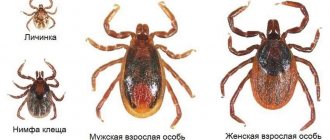Ixodid ticks inhabit places with dense vegetation - parks, forests and alleys, where there are a lot of bushes, trees and grass.
If a blood-sucking parasite gets on the dog’s body, the owner of the animal must react as quickly as possible and remove the parasite.
If this is not done, along with the specific secretion that the tick injects during suction, various blood-parasitic infections penetrate into the blood, threatening not only the health of the pet, but can also cause death.
Where to look?
Ticks live in the grass (and not on birch trees) and cling to dogs from blades of grass. They wait for their prey, spreading their tenacious paws in order to grab onto the animal running past in time. Then the parasite crawls upward, looking for a “softer” place to bite into.
- Stomach;
- Armpits;
- Knee and elbow bends;
- Inner thigh;
- Groin area;
- The space behind the ears and the ears themselves;
- Mucous membranes - mites can be found in the oral cavity on the gums and even on the genitals.
How to remove a tick?
There are many methods for removing ticks, but they are all similar. The main movement is to rotate the tick around its axis. How can you remove a tick from a dog?
Tick remover.
A special device that looks like a spatula with a curved forked plate at the end. This is perhaps the best and most reliable way. The tick is picked up with this device and rotated around its axis 3-4 times. After that, pulling it out is not difficult. It is not difficult to remove a tick using a twister, and there is no risk of leaving the proboscis in the wound.
Tweezers.
Grasp the tick firmly with tweezers as close to the dog's skin as possible. And scroll around its axis. Voila - the parasite has been removed. It sounds simple, and for an experienced person, a veterinarian, for example, removing a tick this way is not a problem. But the average owner runs the risk of leaving the proboscis in the wound.
Thread.
Make a loop of thick thread (a thin one can “cut” the tick when pulled out), throw it over the tick and... spin the parasite around its axis. The method is quite controversial, because it is not always possible to remove an uninvited guest the first time. It is always better to purchase a screwdriver and use it to remove the parasite.
After removing the tick from the dog, disinfect the wound with an antiseptic in one way or another!
Preventive measures
With the onset of warm weather, at home, treat the dog with any modern remedy for blood-sucking parasites. They use drops, spray, tablets, lotion, and attach a special collar. No remedy provides 100% protection, but it reduces the risk of disease significantly. Sprays, drops, lotions act on ticks for about 2 weeks, collars, depending on the active component - from 1 to 3 months.
Additionally, folk remedies are used in the form of decoctions of tansy, wormwood, solutions with the addition of essential oils of lavender, citronella, and lemongrass. Spray the wool from a spray bottle or apply drops.
Each owner decides independently whether to vaccinate against piroplasmosis. But he is obliged to do everything to protect the animal from a dangerous disease.
What to do if part of the tick remains in the dog’s skin?
To begin with, calm down. If the parasite is removed correctly, nothing will remain in the dog, but if done incorrectly, there is a risk of leaving the proboscis in the wound. If this happens, it's okay. It's unpleasant, but not fatal! This is the dead part of the tick’s body and can no longer transmit blood-parasitic diseases to the dog’s body.
The body is designed in such a way that it does not tolerate anything foreign. The bite site will become inflamed, the wound will open, and the tick's proboscis will come out on its own. If you see a pimple where a tick was sitting, just treat it with an antiseptic and observe. Are you very worried? Contact a veterinary clinic.
Flux treatment methods
Treatment should be started as early as possible. If an abscess on the gum opens spontaneously, there is a risk of infection entering the bloodstream. With such an infection, blood poisoning develops, and such a complication can lead to serious consequences, including the death of the patient.
Flux treatment is always complex. The treatment program depends on the degree of tooth decay and the spread of infection.
Dentistry for those who love to smile
+7
Make an appointment
What not to do
The Internet is full of bad advice. Some people are especially surprised - as soon as this comes to mind? Some people advise burning a tick with celandine juice, others – placing a copper coin on the full moon... It is clear that esoteric and folk methods are unlikely to work, so let’s consider myths that are closer to reality.
Let's find out!
1.
The most common myth is to pour oil on a tick and then it will come out on its own. No, it won’t come out, it can even go deeper and more actively secrete salivary fluid - namely, it contains protozoa, which are so dangerous for the dog. In any case, you will have to remove the tick yourself. In addition, the fact that the oil gets into the wound that the parasite will leave behind is not very good.
2.
Covering a tick with nail polish is also a dubious method. Yes, the tick can die, but you still have to pull it out yourself. In addition, local irritation and inflammation of the skin due to the chemical composition of the varnish in dogs has not been canceled.
3.
It's the same with gasoline. No less dubious method! It's better not to take risks. Remember about allergies and skin irritation?
4.
When removing a tick, do not pull sharply, trying to tear the tick away from the dog. Firstly, it’s unlikely to work, and secondly, if it does work, then the probability of leaving a proboscis in the dog is quite high (although there’s nothing wrong with that).
After all, there are simpler ways - why take extra risks?
How does infection occur?
Babesia canis is transmitted transovarially, that is, through the laid eggs of ticks, from which the larvae then hatch. Subsequently, piroplasms that enter the body multiply in the red blood cells of the animal. Insects go hunting as soon as it gets significantly warmer outside. They can attack a dog while walking in a summer cottage, in a forest belt or in the city.
In the spring there are the most infected animals, so it is at this time of year that owners should exercise increased caution: treat or vaccinate in a timely manner, and carefully examine a pet that comes in from the street. In the fall, the number of cases is not so high. Most often, piroplasmosis occurs in purebred dogs - mainly hunting and service dogs. However, mestizos also suffer from it, so every owner should take care of safety in advance and not forget about mandatory seasonal prevention.
photo from website: www.topelection.org
Source
The tick has been eliminated. What's next?
If your dog is treated for ticks (for example, with a Simparika tablet) on time and in accordance with its weight, then simply monitor the animal for 10-14 days. You can have a tick tested, but the likelihood of your dog becoming infected is minimal. If the animal is not protected in any way, then in addition to observation, it is better to submit the tick for examination to a veterinary laboratory. There the parasite will be checked for hemoparasitic diseases and a conclusion will be issued.
Based on the results, your veterinarian will draw up a further treatment and prevention plan. It is important to understand that the presence of pathogens of vector-borne diseases in a tick does not mean that the dog has definitely become infected.
Most diseases are not transmitted to the wound immediately, but 12-48 hours after the bite (except for ehrlichiosis, which is transmitted much earlier). And if you removed the tick earlier than this period, then infection is unlikely.
But in the case where the parasite could not be detected immediately, and it was only possible to get it out 2-3 days after the bite or later, in this case, a positive laboratory conclusion about the presence of blood-parasitic diseases in the tick may be a reason to contact a veterinary clinic before the dog appears the first clinical signs of the disease.
Why ticks are dangerous for dogs and cats
For pets, blood-sucking parasites are just as dangerous as for people, and sometimes more.
Pets can catch diseases from ticks, but owners do not always have time to notice this in time. It is more difficult to detect a parasite on a dog or cat than on yourself. This often happens when the animal has already shown the first symptoms of infection.
Here's what your pet can get sick with Ticks: Life Cycle, Anatomy and Disease Transmission in Cats:
- tick-borne borreliosis (Lyme disease);
- ehrlichiosis;
- babesiosis (pyroplasmosis);
- theileriosis;
- hemobartonellosis;
- hepatozoonosis;
- Rocky Mountain spotted fever;
- tick paralysis;
- tularemia.
What is piroplasmosis and how to understand that your dog is sick
Piroplasmosis (also known as babesiosis) is a hemoparasitic disease caused by the protozoa Babesia canis or Babesia Gipsoni. A dog can become infected after a tick bite - along with saliva, the tick penetrates the dog's bloodstream and infects red blood cells - red blood cells that carry oxygen.
- Lethargy, apathy, refusal to eat;
- Fever (normal dog temperature is 37.5 – 39.0°C).
- Yellowness of the mucous membranes, sclera and skin;
- Urine is deep orange or red in color.
If any of these symptoms occur, visit your veterinarian immediately! Without treatment, piroplasmosis is fatal!
Possible consequences of tick-borne encephalitis in dogs
Complications are associated with the specific behavior of the virus - the “enemy” penetrates red blood cells and destroys them from the inside. A visual improvement in the dog’s condition after the start of treatment is observed within 10–12 hours, but this is not associated with a complete recovery, but with a weakening of the disease. The process of illness and treatment can be divided into several stages:
- The virus cells that are found in intact red blood cells actively multiply, destroying the “temporary shelter.”
- Fragments of dead cells are excreted from the body through the kidneys. A large flow of waste and toxicity of the body leads to overload, resulting in chronic renal failure.
- After the start of treatment, a “blow” occurs to the liver and central nervous system.
Maintenance therapy reduces the risk of the following complications:
- Kidney failure due to blockage of the channels by dead cells.
- Liver failure is provoked by the active substance of the vaccine against piroplasmosis.
- Heart failure and hypotension are provoked by a drop in hemoglobin levels and oxygen starvation, due to the massive death of red blood cells.
- Chronic anemia is a lack of essential substances for hematopoiesis, reduced hemoglobin, “fading” of metabolic processes.
- Damage to the central nervous system most often manifests itself as convulsions and ends in death. The main cause is cerebral edema caused by tissue inflammation. The question of whether dogs suffer from tick-borne encephalitis is considered controversial. Considering the similarity of symptoms and clinical picture, it follows that encephalitis can be a consequence of piroplasmosis. However, death occurs in too short a time, which does not allow the diagnosis to be fully differentiated.
What can a dog become infected with from a tick besides piroplasmosis?
The most common disease that ticks carry is piroplasmosis. But besides it, there are others. For example, ehrlichiosis.
For example - ehrlichiosis
. Infection also occurs through the saliva of the tick. The danger of ehrlichiosis is that it can occur in a chronic form for years, gradually affecting the dog’s body more and more. It is difficult to detect the symptoms on your own; they are very vague.
What you should be wary of:
- Arthritis – inflammation of the joints;
- Enlarged lymph nodes;
- Periodic increase in temperature;
- Apathy, lethargy, loss of appetite;
- Blood clotting disorder – even from a minor wound the bleeding does not stop for a long time.
It is precisely such infections that are difficult to notice that are the reason to submit the tick to a laboratory for analysis.
Anaplasmosis (infectious thrombocytopenia) is also a disease transmitted by ticks.
The causative agent of anaplasmosis is the protozoan Anaplasma phagocytophillum, as well as Babesia, they live in the salivary glands of the tick and are transmitted to the dog through a bite.
If piroplasmosis affects red blood cells, then the target of anaplasma is platelets. Accordingly, the dog develops problems with blood clotting.
Symptoms:
- The appearance of bruises “out of nowhere”;
- Urine is red in color;
- Fever;
- Weakness of the hind limbs;
- Nausea, vomiting;
- Diarrhea;
- Enlarged lymph nodes.
Any of these symptoms is a reason to urgently contact a veterinary clinic for help. Delay can be deadly - anaplasmosis occurs both in a delayed form and in an acute (platelet) form.
There are many blood parasitic diseases, but their symptoms are generally similar. Therefore, if there is any deviation from the norm in the dog’s well-being, seek help from a veterinary clinic. By the way, dogs do not get tick-borne encephalitis. This is an exclusively “human” infection.
Symptoms of a bite
If a dog is bitten by a tick, this can be recognized by symptoms, but they are classified depending on the stage and form of the disease. It can be acute, partially acute and chronic.
Acute form of the disease
In this case, the signs of a tick bite in a dog are as follows:
- Reluctance to eat food;
- the occurrence of severe shortness of breath;
- change of colors in the mucous membrane area;
- increased body temperature;
- the bitten dog has no reaction to commands;
- increased heart rate;
- increase in hemoglobin level in urinary fluid.
Most often, this form of the disease occurs if the dog has not previously suffered a tick bite. If a dog is bitten by a tick, the pulse slows down noticeably. Gait becomes more difficult and the hind limbs become weaker. Intestinal atony may occur. In the absence of timely measures taken, dog ticks in this form can be fatal.
Chronic form of the disease
Typically, this type of dog tick occurs in dogs that have previously suffered from the disease. The symptoms of a tick bite in this case are as follows.
- Reluctance to eat;
- noticeable increase in body temperature;
- subsequent normalization of temperature;
- general weakness and exhaustion;
- diarrhea and other intestinal disorders;
- rapid fatigue of the dog;
- sudden change in mood;
- cachexia and anemia.
The duration of the acute stage is 1.5 months. The symptoms pose a danger to the dog’s life and health, so it is necessary to wisely choose anti-tick medications for dogs that promote a quick recovery.
Why Simparica?
Many people are surprised - how can a tablet save a dog from a tick? It's a pill, it can't affect the skin. How can it! The active ingredient of Simparica, sarolaner, is absorbed from the stomach and distributed through the bloodstream throughout the body. The tablet begins to work within 3 hours after use, and reaches the maximum degree of protection against ticks after 12 hours.
The mechanism of action of Simparika is such that after a tick bite, the active substance affects the nervous system of the parasite, and it dies before the hemoparasites have time to penetrate the animal’s bloodstream. At the same time, the dog’s body is structured differently and Simparika does not have a negative effect on the nervous system and the functioning of the animal’s internal organs.
Prevention
Unfortunately, today there is no 100% effective means of protection against piroplasmosis. And this is not surprising, because Babesia is not a virus, but a parasite. Therefore, the most effective prevention of piroplasmosis was and remains the protection and prevention of infection of your beloved pet from ticks.
But here the pet market offers many different products: collars, sprays, drops, tablets. We will not describe each of them in detail. Read about modern flea and tick treatments for dogs. There we talk in detail about the most popular ones.
A few years ago, to the delight of dog breeders, a vaccine was invented. But, unfortunately, it also does not provide a 100% guarantee against infection. The vaccine can only neutralize the toxic substances released by Babesia and, thereby, promote a speedy recovery of the pet after treatment. The effect of the vaccine is not so durable - only 6 months. But in the case of a tick bite, death is almost completely excluded. Today, according to veterinarians, the most effective are two vaccines: Pirodog and Nobivac Piro.
Whatever preventive methods you use to protect your beloved pet from piroplasmosis, it is important to examine the dog after every walk.











